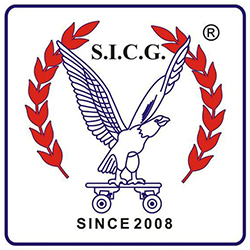Skates India Club & Group
(Academy of Roller Skating)
Recognized by:
A. Trade Marks Act, 1999 [Section 23(2), Rule 56(1)] Trademark No. 3614628
B. MSME (Govt of India) C. Rajasthan Societies Registration Act, 1958
D. ISO Certified 45001:2018 Certificate No: ICI/1849135/22
Key features

1. Wear The Right Protective Gear
Note: If you start out wearing protective gear you will learn more quickly because you will be confident and relaxed.
Here's a list of what you need to wear:
- Helmet
- Protective Gear
- Skating socks
2. Skate Without Falling
- Bend your knees so that when you look down at your toes your knees hide your view of them. This will lower your center of gravity so that you will be more balanced.
- If you do lose your balance, stretch your palms forward touching the pavement first with your wrist guards, then your knee pads, and finally your elbow pads. These guards have plastic caps so that you will slide over the skating surface thus minimizing the impact of the fall.
- When you start skating, find a place that is level and smooth like a roller rink, and has little or no traffic - like a parking lot on Sunday.
3. Skate Posture
- Skating is squatting, meaning that when you skate your body should be as low as possible to the ground for maximum balance: knees bent and shoulders slightly forward. Hands are best kept low and in front.
- Let's Go!
- The easiest method to start skating is to walk like a duck, toes pointed out, heels together so that your skates are in a v-shaped position. Take a few steps, right, then left, then right. Gradually you will feel confident enough in your balance to let each step become a glide. Having the heels of your skates directly beneath your body allows you to put more pressure on the heel wheels, which propels you forward with each glide. Push from your heels to go forward with no pressure on the toes. (This means that when you push on your toes you will go backward.
4.Stopping
- Skate brakes are added to the back of the right skate. The California Skate Brake is designed for the roller skate while most recreational inline skates come equipped with a brake assembly attached to the right heel. The right leg is the power leg and power is what is needed to use the brake to the best advantage.
- The success of braking depends on the skater's ability to put full pressure on the right heel brake. Just as in an automobile the brake pedal does not stop the car unless the driver PUSHES on it, so the skate brake won't stop the skate unless the skater puts full pressure on that heel. To practice braking, the skater should be gliding, shoulders slightly forward and knees bent. Glide with both skates parallel and close together as possible. Roll the right skate forward but not in front of, the left skate so the right heel brake is a little ahead of the left skate's toe wheel. Quickly lift the front wheels of the right skate and push downward on the heel brake - HARD. The more pressure applied to the brake, the quicker the stop. The beginner skater can use both hands to push down on the right knee to increase pressure on the right heel brake.
-
The 'T-Stop'
The T-STOP is an intermediate method of braking. In order to t-stop the skater must have the ability to glide for at least 20 to 40 feet on one leg. As you are gliding on the front leg, you lightly drag the other skate's wheels behind. Because the back skate is perpendicular (90 degrees) to the front, this method is called the T-STOP. -
T-stopping can only be accomplished if the skater does not lean back on the rear skate, or use it to balance. The rear skate is like a parachute on the back of a jet landing on the deck of a ship - dragging to a stop. If you practice gliding on one leg with your body leaning forward parallel to the ground, then dragging the other foot perpendicular, this will stop you and not turn you around which happens when skaters put pressure on the wheels of the back skate.
-
The 'V-Stop' (Inline Skating)
Use the V-stop for braking if you are skating slowly. In the 'V' stop, you use both skates. Form a 'V' shape with both skates facing either forward or backward. You want to bring your skates converging onto each other, or diverging from each other, thus bringing about a slowing down and eventual stopping. This method works because the skater is pushing against the inside edges of the toe wheels when moving forward or the inside edges of the heel wheels when moving backward.


